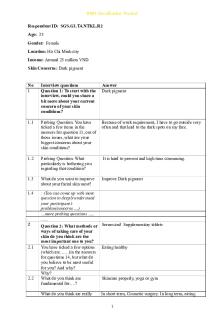GS transcript - Easy PDF

| Title | GS transcript - Easy |
|---|---|
| Author | Rahiq Raees |
| Course | Mathematics |
| Institution | York University |
| Pages | 10 |
| File Size | 119.6 KB |
| File Type | |
| Total Views | 149 |
Summary
Easy ...
Description
Get Started Online Module Slide 2 The information in these modules will show you how you can complete your degree at UTSC. We will go through information regarding degree requirements, program choices, course selection and course planning. You will also see a demonstration video of a student at the end. You can go through the information in these modules at your own pace by using the navigation bar below.
Slide 3 The Registrar’s guide is an important document that students need refer to. This has information regarding academic deadlines, course enrolment, program and degree completion, academic standing, and exam information. The finances section outlines information about financial deadlines, paying and deferring fees, tuition refunds, financial aid, and scholarship. Under the support section, you will find a list of student services, information about the student card called the TCard, glossary of terms, and the academic success agenda. Make sure to go through the Registrar’s guide before moving onto the next slide.
Slide 4 The calendar is published every year. For example, this year’s calendar is in effect throughout the fall, winter, and summer sessions. In this, you can find information on academic policies such as academic integrity, standing and, grades. You can also find information on degree and program requirements, information on selecting courses, and a list of courses in each subject areas. By using the course search feature, you can look for courses based on the subject areas or breadth requirement categories. The previous calendars could be found under the PDF & Archived section.
Slide 5 You can graduate with one of the 3 different degree types. The type of programs you study will determine the type of the degree you will graduate with. If you complete a specialist or a major in the arts, you will graduate with an Honours Bachelor of Arts. If you complete a specialist or a major in the sciences, you will graduate with a Honours Bachelor of Science. For those of you who study both the arts and science majors, you can choose either the Arts or the Science degree. Students who study Management or Economics specialist will graduate with the Bachelor of Business Administration degree. UTSC also offers combined degrees and double degrees. You can click on the links for further information.
Slide 6 Students usually complete the degree requirements from the calendar, which was published during year they were admitted into UTSC. However, they could also complete the degree requirements listed in any calendars between the first and last registration at UTSC. Your degree requirements will consist of the following requirements. You must complete 20.0 credits. Within the 20 credits, a half credit must be from each of the 5 breath requirement categories. 5.0 credits must be at the C or D level, plus 1.0 credit must be at the D level. You need to complete appropriate programs and if you complete 2 or 3 programs, you need at least 12.0 distinct credits between the program requirements. You need to meet the minimum cumulative grade point average listed in the degree requirement you are completing. For specific details, take a look at the degree requirements from the calendar you are following. The next few slides will go over these requirements in detail.
Slide 7 To receive your degree, you need to complete 20 credits. H courses are worth half credit and Y courses are worth 1.0 credit. Since most of the courses at UTSC are H courses, you will likely complete 40 courses to complete the 20.0 credits.
Slide 8 You will need to complete a half credit in each of the five breadth requirement categories listed on the screen. All the courses at UTSC are assigned with breath requirement categories. You can find this information in the course description. Click on the button on the screen to open the course finder. You can search for courses based on the breath requirement category by clicking on University of Toronto Scarborough under the Requirement section.
Slide 9 The courses at UTSC are offered at the A, B, C, and D levels. Of the 20.0 credits you complete you need to complete at least 5.0 credits at the C or D level, plus 1.0 credit at the D level. For example, if a student completes 4.0 credits at C and 0.5 credit at the D levels within a specialist the depth requirement will be incomplete. If the student completes additional 0.5 credit at C and 1.0 at the D levels, then the depth requirement will be complete.
Slide 10 Remember, in order to complete your degree, you need to study one of the 3 combinations of programs. Here are your options: You can either complete 1 Specialist or 2 Majors, each of the major or 1 Major & 2 Minors If you do the math, you could see that none of these options will add up to the 20 credits you need to graduate. This is where electives come in. Electives could be taken in any area of studies and you can use them to complete the 20.0 credits requirement.
Slide 11 Let’s review the 12 distinct credit rule. This rule applies to students who are completing more than one program, so if you are completing 1 specialist, you don’t need to worry about this rule. If you are studying 2 majors or 1 major and 2 minors combinations, you need to make sure that you have at least 12 different credits between your program requirements.
You can use the same course for more than one program. Let’s look at an example of a student who is studying 2 majors. This student is allowed to use the same set of courses listed in the overlapping section of the Venn diagram. However, the program requirements between two majors must add up to 12 different credits. In this example, the student would have 14 credits between the 2 majors that are different, so this student would meet the 12 distinct credit rule. In some cases, 2 majors may not add up to 12 different credits, because the courses are too similar between 2 majors. In this is the case, you have an option of completing an additional minor so you could combine the credits from the minor with the 2 majors. This will increase the number of credits amongst your program requirements so that you could complete at least 12 credits between your programs. If you are studying one major and 2 minors, you need to count the credits between your programs to make sure you complete 12 different credits as well. Download the 12 distinct credits tipsheet to map out your program requirements to ensure that you meet this requirement.
Slide 12 By the end of your degree, you must meet the minimum cumulative grade point average from the degree requirement you are following. You need at least a 1.85 CGPA, for Honours Bachelor Science and Honours Bachelor of Arts degrees. If your CGPA is at least 1.6 but less than 1.85, you will graduate with a bachelor degree. Some programs require higher CGPA to complete the program requirement, so you need higher CGPA to graduate. Refer to the calendar for specific CGPA requirement to complete your program. If you are completing the Bachelor of business administration degree, you need a minimum of 2.0 CGPA to graduate. To learn more about the grade point average, click the button on the slide.
Slide 13 When you read the course description, you will notice that there may be some requirements listed at the bottom. The prerequisites are courses you need to take before you are qualified to take this course. If you register in a course without the pre-requisite, you may be removed from the course. Corequisites are courses you must take in the same semester unless you have passed these courses previously. Exclusions are courses that are very similar to this course. If you have taken any courses listed here, you cannot take this course for credit and this will not be used toward your degree requirement. Breath requirement indicates the breadth categories this course belongs to. There are two types of brackets. The square bracket indicates a group of courses and the round bracket indicates courses that are no longer offered.
Slide 14 From the course code, you can decipher several pieces of information. PHY is the course subject area. In this case, this is a physics course. The courses level ranges from A to D. A indicates that this is the most elementary level course. D level courses are the most advanced. 21 is the course identifier and in most cases the number has no significance H indicates that the credit value of this course is a half credit. Y courses are worth a full credit. 3 is the campus identifier and this will indicate where the course is being held. 3 means that this is a UTSC course.
Slide 15 It’s important to pay attention to the pre and co-requisites, if you are enrolled without these requirements you could be removed from your courses at any time. Let’s look at an example of a course sequence. As you could see here, you must take the 2 A level biology courses in order to take the B level courses. Then you can take the C level and then move onto the D level course.
Slide 16 Unless you were directly admitted to a certain program, you will need to choose and apply to your program(s) at the end of your first year. When you are selecting your programs, a good starting point would be to review the types of programs that are offered. Here are a few of questions you should ask when you are exploring your program options. You can find more information about the programs, by clicking on the calendar link on this screen. The calendar contains information about program requirements, enrolment information, and recommended first year courses. If you want to know more about the programs, you can click on the Choosing your program link. Here, you will find the career options tipsheets, student testimonials, and the online guide to help you select your programs.
Slide 17 It’s important to know the difference between the two types of programs because the admission procedures are different. The limited programs have a set number of spaces for students while the unlimited programs do not. The limited programs are not necessarily better than the unlimited programs. Once you complete 4 credits at the end of your first year, you need to enroll in programs.
To apply to the limited programs, you need to complete specific courses. Acceptance into the program is based on your CGPA. This usually means that these programs are competitive. You can apply to the limited programs on ACORN twice a year. The unlimited programs on the other hand have enough spaces for students who want to enroll in these programs and they are open to all students. There are no enrolment requirements, and you can enroll on AOCRN at any time.
Slide 18 You can find your admission category in your letter of offer. If you see you’re your admission category in the first column, you were directly admitted into a specific program. This means that you don’t have to enroll in programs at the end of your first year. Since you can complete the program requirements listed in the calendar from the year you were admitted into your program, you can use the program requirements listed in the current calendar or the calendar from any subsequent years. If you have been admitted into the co-op category, you need to enroll in eligible co-op programs once you complete 4 credits. This is usually at the end of the first year. This means that you can use the program requirements listed in the calendar when you add the program or subsequent calendar years. If you have been admitted into a collection of programs, you need to enroll in programs after you complete 4.0 credits. This means that you can use the program requirements listed in the calendar when you add the program or subsequent calendar years. You can take a look at the UTSC program options document to see what types of programs are available in your admission category. For detailed information regarding each of the program options read the information on the calendar. You can choose to programs related to the admission category you were admitted into or you can choose to enrol in other subject areas.
Slide 19 Download the course planner and follow these 9 easy steps to schedule your first-year courses. You can click on the links on the course planner, fill it out as you progress through the module, and save this to your computer.
Slide 20 Step 1 (moved from slide 23) First, read your admission letter and find out what your admission category is. Then, click on the checkbox next to your admission category on the course planner.
Step 21 If you see your admission category under the Direct admission into a program section, you are already in a program. So this means, you don’t need to apply to programs at the end of your first year. If you see your admission category under the Admission into a co-op category or Admission into a collection of programs, you are not in a program yet. So, you must choose your programs once you complete 4.0 credits. You could study 1 specialist, 2 majors or 1 major and 2 minors. You can find a list of program options for your admission category on the program options website. To understand what the programs are like and what courses you need to take, open up the UTSC calendar. If you were admitted into co-op, you must choose 1 specialist or 1 major program that is co-op eligible. You can find this on the program options website. Once you have decided which program options you plan to study, type them into the textbox on the course planner.
Slide 22 Step 3 Next, look up the program type of the programs you want to study. If the program is unlimited, there are no enrolment requirements for the program, so you can add yourself into the program at anytime. If the program is limited, pay a careful attention to the enrolment requirements such as a list of courses and a minimum grade listed under the program description in the calendar. Then, find the first-year courses for the programs you want to study. On the UTSC calendar, you can find this by clicking on the Calendar sections and looking for guideline for first-year course selection. Sometime, you may find this information under the individual program title so look for the A level courses and add them to your course list. Once you have identified your first-year courses, enter the course codes into the textbox under step 3.
Slide 23 Step 4 Students admitted into certain categories are pre-enrolled into some of their courses, so check ACORN to see if you have been pre-enrolled into your courses prior to creating your schedule. Step 5 Once you know which courses are required for the program, you can use the Course Timetable to find out the time and the day of the lecture. If there is a tutorial or a practical available, you need to enrol in these as well. You can use the Timetable plan feature to create your weekly schedule and save this as a pdf. If you were admitted into coop, the co-op
department will enrol you into a coop work term prep course by the end of the summer. Take a look at the timetable, select co-op workterm prep course to find out when this course will take place. Step 6 If you have space in your schedule, add your electives. Electives are courses that are not part of the program. Since program requirements do not add up to 20 credits you need to complete the degree requirement, you would need to take elective courses.
Slide 24 Step 7 Once you create your schedule, you may add your courses into your Enrolment cart on ACORN prior to the official course enrolment date. Step 8 The official course enrolment date for first year students is on July 8th. However, you will be assigned a specific time to enrol in your courses on this date. Starting on July 2nd, you can log into ACORN to view your enrolment time. Step 9 On July 8th, remember to officially enrol in both first and second semester courses by clicking on the ‘Enrol” button. Make sure that your courses appear under the ‘Currently enroled’ section.
Slide 25 Here is a student example. AJ was accepted into the Life sciences admission category. After exploring program options, AJ decided to study Human biology and Political science majors. First, AJ looked up whether the programs are limited or unlimited, and found out that human biology was a limited program and political science was an unlimited program. From the calendar, AJ learned that the first year courses for human biology should include the A levels in biology, chemistry, math, and psychology courses. The political science major listed A level political science courses. There was room for one elective, so a geography course was added. AJ applied to the Human biology major in April and was accepted in May and added political science major on ACORN.
Slide 26 Before figuring out the schedule, AJ checked ACORN and saw that biology and chemistry lectures were preenrolled for fall and winter semesters. By using the course timetable, AJ looked up when the courses are offered. AJ had to add the practicals for biology and chemistry into ACORN and, the rest of the first-year courses for Human biology, including psychology and math were added. The political science courses were added to the schedule. The geography course was added to the schedule as an elective.
Slide 27 When you enrol in your courses on ACORN, it may not flag problems with prerequisites, corequisites, and exclusions. If you enrol in a course without the prerequisite, you will be removed the course. When you register in your courses, you need to pick courses for the fall and winter semesters. If you wait to sign up for the winter courses, they will most likely be full. If a course is full, you may have the option of joining the waitlist. If you are the first person on the waitlist, and someone drops out you will be added to the course. If you are on the waitlist, try to check your status on ACORN on a regular basis to see if you have been added to the course. If you are not doing well in a course and this is affecting your GPA, you can drop this course. Make sure you drop the course by the deadline. Consider this especially, if you are in a program which requires you to maintain a minimum GPA. There are some questions you need to consider if you are thinking about dropping a course. Is it a program requirement? When is it offered again? Is it a pre-requisite for a course that I’m taking next semester? Is this going to affect my OSAP? If you need help to weigh your options, you can drop by the Academic Advising & Career Centre to talk to a staff member.
You can take courses at other UofT campuses. In your first 4.0 credits at UTSC, only 1.0 credit can be from another campus. If you are taking a program requirement at another campus, check with your program supervisor to make sure that it could be used toward your program. Overall, you can complete up to 5 credits toward your degree at UTSC at other campuses....
Similar Free PDFs

GS transcript - Easy
- 10 Pages

Transcript
- 2 Pages

Übergang Kita GS
- 5 Pages

Prüfungsaufgaben GS-MS
- 19 Pages

Lexus GS 450H kasua
- 2 Pages

Transcript 2
- 3 Pages

SGS transcript
- 3 Pages

GS Geo AB9 Loesung
- 2 Pages

Interview transcript
- 7 Pages

N4685M1 transcript
- 7 Pages

Math - Easy
- 9 Pages

GS Key Exam Practice Test
- 20 Pages

Easy Dent
- 79 Pages

Musculoskeletal Transcript
- 10 Pages
Popular Institutions
- Tinajero National High School - Annex
- Politeknik Caltex Riau
- Yokohama City University
- SGT University
- University of Al-Qadisiyah
- Divine Word College of Vigan
- Techniek College Rotterdam
- Universidade de Santiago
- Universiti Teknologi MARA Cawangan Johor Kampus Pasir Gudang
- Poltekkes Kemenkes Yogyakarta
- Baguio City National High School
- Colegio san marcos
- preparatoria uno
- Centro de Bachillerato Tecnológico Industrial y de Servicios No. 107
- Dalian Maritime University
- Quang Trung Secondary School
- Colegio Tecnológico en Informática
- Corporación Regional de Educación Superior
- Grupo CEDVA
- Dar Al Uloom University
- Centro de Estudios Preuniversitarios de la Universidad Nacional de Ingeniería
- 上智大学
- Aakash International School, Nuna Majara
- San Felipe Neri Catholic School
- Kang Chiao International School - New Taipei City
- Misamis Occidental National High School
- Institución Educativa Escuela Normal Juan Ladrilleros
- Kolehiyo ng Pantukan
- Batanes State College
- Instituto Continental
- Sekolah Menengah Kejuruan Kesehatan Kaltara (Tarakan)
- Colegio de La Inmaculada Concepcion - Cebu

